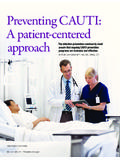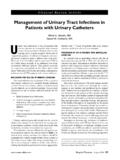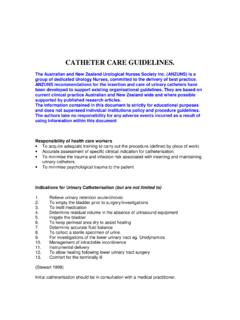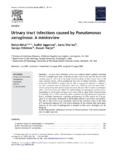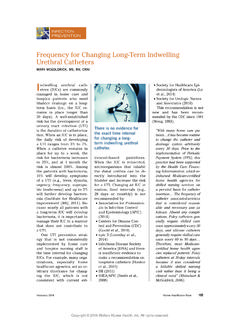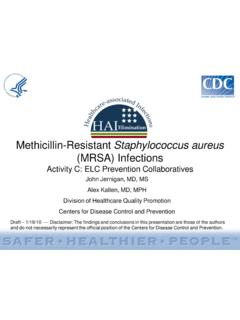Transcription of Catheter-associated Urinary Tract Infection (CAUTI) …
1 Catheter-associated Urinary Tract Infection (CAUTI) Toolkit Activity C: ELC Prevention Collaboratives Carolyn Gould, MD MSCR Division of Healthcare Quality Promotion Centers for Disease Control and Prevention Disclaimer: The findings and conclusions in this presentation are those of the authors and do not necessarily represent the views of the Centers for Disease Control and Prevention. Outline Background Impact HHS Prevention Targets Pathogenesis Epidemiology Prevention Strategies Core Supplemental Measurement Process Outcome Tools for Implementation/Resources/References Background: Impact of CAUTI Most common type of healthcare- associated Infection > 30% of HAIs reported to NHSN Estimated > 560,000 nosocomial UTIs annually Increased morbidity & mortality Estimated 13,000 attributable deaths annually Leading cause of secondary BSI with ~10% mortality Excess length of stay 2-4 days Increased cost $ billion per year nationally Unnecessary antimicrobial use Hidron AI et al.
2 ICHE 2008;29:996-1011 Givens CD, Wenzel RP. J Urol 1980;124:646-8 Klevens RM et al. Pub Health Rep 2007;122:160-6 Green MS et al. J Infect Dis 1982;145:667-72 Weinstein MP et al. Clin Infect Dis 1997;24:584-602 Foxman B. Am J Med 2002;113:5S-13S Cope M et al. Clin Infect Dis 2009;48:1182-8 Saint S. Am J Infect Control 2000;28:68-75 Background: Urinary catheter Use 15-25% of hospitalized patients 5-10% (75,000-150,000) NH residents Often placed for inappropriate indications Physicians frequently unaware In a recent survey of hospitals: > 50% did not monitor which patients catheterized 75% did not monitor duration and/or discontinuation Weinstein JW et al. ICHE 1999;20:543-8 Munasinghe RL et al.
3 ICHE 2001;22:647-9 Warren JW et al. Arch Intern Med 1989;149:1535-7 Saint S et al. Am J Med 2000;109:476-80 Benoit SR et al. J Am Geriatr Soc 2008;56:2039-44 Jain P et al. Arch Intern Med 1995;155:1425-9 Rogers MA et al J Am Geriatr Soc 2008;56:854-61 Saint S. et al. Clin Infect Dis 2008;46:243-50 Background: HHS Metrics and Prevention Targets # of symptomatic UTI / 1,000 Urinary catheterdays as measured in NHSN National 5-Year Prevention Target: 25% decrease from baseline Appendix G in HHS plan discusses a new type of metric, the standardized Infection ratio (SIR) Background: Pathogenesis of CAUTI * Source of microorganisms may be endogenous (meatal,rectal, or vaginalcolonization) orexogenous, usually viacontaminated hands of healthcare personnelduring catheter insertionor manipulation of the collecting system Figure from: Maki DG, Tambyah PA.
4 Emerg Infect Dis 2001;7:1-6 Background: Pathogenesis of CAUTI Formation of biofilms by Urinary pathogens common on the surfaces of catheters and collecting systems Bacteria within biofilms resistant to antimicrobials and host defenses Some novel strategies in CAUTI prevention have targeted biofilms Photograph from CDC Public Health Image Library: Scanning electron micrograph of S. aureus bacteria on the luminal surface of an indwelling catheter with interwoven complex matrix of extracellular polymeric substances known as a biofilm CAUTI Definitions Surveillance definitions for UTI recently modified in NHSN (as of Jan 2009) Please refer to NHSN Patient Safety Manual Count symptomatic UTI (SUTI) only, not asymptomatic bacteriuria (ASB) Exception is ABUTI (asymptomatic bacteremic UTI)
5 See NHSN manual above Clinical significance of ASB unclear Should not screen for or treat ASB routinely, except in certain clinical situations Most literature to date includes ASB in outcomes, making interpretation of data difficult Evidence-based Risk Factors for CAUTI Symptomatic UTI Bacteriuria Prolonged catheterization* Disconnection of drainage system* Female sex Lower professional training of inserter* Older age Placement of catheter outside of OR Impaired immunity Incontinence Diabetes Meatal colonization Renal dysfunction Orthopaedic/neurology services * Main modifiable risk factors Also inform recommendations Prevention Strategies Core Strategies Supplemental High levels of Strategies scientific evidence Some scientific evidence Demonstrated Variable levels of feasibility feasibility *The Collaborative should at a minimum include core
6 Prevention strategies. Supplemental prevention strategies also may be used. Most core and supplemental strategies are based on HICPAC guidelines. Strategies that are not included in HICPAC guidelines will be noted by an asterisk (*) after the strategy. HICPAC guidelines may be found at Core Prevention Strategies (all Category IB) Insert catheters only for appropriate indications Leave catheters in place only as long as needed Ensure that only properly trained persons insert and maintain catheters Insert catheters using aseptic technique and sterile equipment (acute care setting) Following aseptic insertion, maintain a closed drainage system Maintain unobstructed urine flow Hand hygiene and Standard (or appropriate isolation) Precautions Core Prevention Strategies Specific recommendations (IB) Insert catheters only for appropriate indications Core Prevention Strategies Specific recommendations (IB)
7 Insert catheters only for appropriate indications Minimize use in all patients, particularly those at higher risk of CAUTI and mortality (women, elderly, impaired immunity) Avoid use for management of incontinence Use catheters in operative patients only as necessary Core Prevention Strategies Specific recommendations (IB) Leave catheters in place only as long as needed Remove catheters ASAP postoperatively, preferably within 24 hours, unless there are appropriate indications for continued use Core Prevention Strategies Specific recommendations (IB) Insert catheters using aseptic technique and sterile equipment (acute care setting) Perform hand hygiene before and after insertion Use sterile gloves, drape, sponges, antiseptic or sterile solution for periurethral cleaning, single-use packet of lubricant jelly Properly secure catheters Core Prevention Strategies Specific recommendations (IB) Following aseptic insertion, maintain a closed drainage system If breaks in aseptic technique, disconnection, or leakage occur, replace catheter and collecting system using aseptic technique and sterile equipment Consider systems with preconnected, sealed catheter -tubing junctions (II) Obtain urine samples aseptically Core Prevention Strategies Specific recommendations (IB)
8 Maintain unobstructed urine flow Keep catheter and collecting tube free from kinking Keep collecting bag below level of bladder at all times (do not rest bag on floor) Empty collecting bag regularly using a separate, clean container for each patient. Ensure drainagespigot does not contact nonsterile container. Core Prevention Strategies: Specific recommendations (IB) Implement quality improvement programs to enhance appropriate use of indwelling catheters and reduce risk of CAUTI Examples: Alerts or reminders Stop orders Protocols for nurse-directed removal of unnecessary catheters Guidelines/algorithms for appropriate perioperative catheter management Supplemental Prevention Strategies.
9 Examples Consideration of alternatives to indwelling Urinary catheterization (II) Use of portable ultrasound devices for assessing urine volume to reduce unnecessarycatheterizations (II) Use of antimicrobial/antiseptic-impregnated catheters (IB, after first implementing core recommendations for use, insertion, and maintenance ) The following slides will provide further details on supplemental Supplemental Prevention Strategies: Alternatives to Indwelling Catheterization Intermittent catheterization consider for: Patients requiring chronic Urinary drainage for neurogenic bladder Spinal cord injury Children with myelomeningocele Postoperative patients with Urinary retention May be used in combination with bladder ultrasound scanners External ( , condom) catheters consider for: Cooperative male patients without obstruction or Urinary retention Supplemental Prevention Strategies: Bladder Ultrasound Scanners Rationale.
10 Fewer catheterizations = lower risk of UTI 2 studies of adults with neurogenic bladder undergoing intermittent catheterization Inpatient rehabilitation centers Fewer catheterizations per day but no reported differences in UTI Significant study limitations: likely underpowered; UTIs undefined Polliak T et al. Spinal Cord 2005;43:615-19 Anton HA et al. Arch Phys Med Rehab 1998;79:172-5 Supplemental Prevention Strategies: Antimicrobial/Antiseptic-Impregnated Urinary Catheters Considered using if CAUTI rates not decreasing after implementing a comprehensive strategy First implement core recommendations for use, insertion, and maintenance Ensure compliance with core recommendations Supplemental Prevention Strategies.











